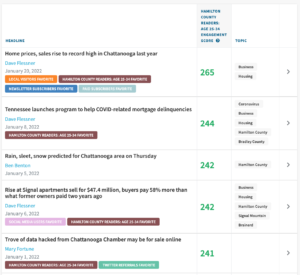Moving On From The Way It’s Always Been Done
A recent cohort hosted by Metrics for News – Reaching New Audiences – brought together publishers from around the world to look at data-driven strategies to reach new audiences. Below is the result of a successful experiment at The Chattanooga Times Free Press to reach younger audiences by rethinking its approach to a major annual city event.
Executive Summary
The Chattanooga Times Free Press wanted to see if it could attract younger readers by shaking up its approach to event coverage. It has historically relied on the public to send event notices and published that information in roundups and guides that included everything from turkey shoots in outlying counties to festivals downtown. But when the annual MAINx24 rolled around, it went deeper with a piece of service journalism aimed at helping people make the most of the 24-hour event that’s been celebrated on Chattanooga’s Main Street since 2007. The event takes place in Chattanooga’s Southside, which is a big nightlife and social gathering spot for people of all ages, but especially young professionals and families.
The Experiment
In its quest to better serve audiences between the ages of 25 and 44, the Chattanooga Times Free Press embarked on a mini-experiment. Instead of taking its usual approach to event coverage, it wrote a feature story aimed at helping readers fully embrace the quirkier aspects of the city’s 24-hour event MAINx24. It displayed the story prominently on the Times Free Press website and promoted it heavily on Facebook and Instagram. The story scored well across most demographics, except the key 25 to 44-year-old demographic editors had been targeting with the piece.
It was a reminder that “you can’t just expect all of a sudden to start serving an audience and expect them to find you immediately,” said Allison Shirk, the paper’s digital and engagement editor.
Audience Development Tip: Just because you build it, doesn’t mean audiences will come, especially if you’ve overlooked them in the past.
A dive into the newsroom’s data showed the most popular category of content with this age group isn’t entertainment as the newsroom had assumed. It’s business news that tends to engage this audience, something Shirk says makes sense for a city with a thriving young professional community.
Metrics for News Tip: Create a segment in your analytics platform for the demographic you’re trying to reach and look at dashboards to see if the content you think is resonating with an audience really is meaningful to that audience. The chart below shows a list of stories and how they perform with 25-34 year olds in Hamilton County, Tenn. The scores are blended engagement scores specific to Metrics for News. Blended engagement scores allow publishers to create a comprehensive view of engagement by combining the many metrics they care about into a single score.

In a second mini-experiment, the Times Free Press ran an extended version of a spring event guide online, one that included several events that didn’t make the print edition, including local beer festivals happening that might interest younger demographics. The guide has been performing well across all demographics, including very high scores for the 35-44 age group.
The story garnered an engagement score of 218 among the key subscriber demographic. Among 35 to 44 year-olds, it had a score of 247. Among 25 to 34-year-olds, the story had an engagement score of 159.
Audience Development Tip: Don’t give up an idea that doesn’t work once. The idea may be the right one but the execution may need adjusting to reach your targeted audience(s).
Metrics for News Tip: In March, the Times Free Press split their 25-44-year-old audience segment into two separate audience segments to better understand what content is resonating with people in different life stages within the broader segment. The newsroom now has two younger audience segments they watch closely, ages 25-34 and 35-44, and thinks more closely about which group each story aims to speak to.
Next Steps
Armed with audience data and feedback from its experiments, the Times Free Press is turning its focus to outreach and qualitative research. To better inform editorial decision-making, the newsroom is beginning to meet with audience members in the target demographic in various settings, including through the Young Professionals of Chattanooga, and hopefully, a new downtown social club. Many of the club’s members tend to be in their 30s and 40s and are likely to have a high enough income to afford the paper’s $34-a-month subscription price.
Try This Out In Your Newsroom
Identify a local event or story you cover every year. How might you take a different approach to better serve the new audience you’re looking to develop?
— This case study was written by Meena Thiruvengadam, one of the lead trainers of the Reaching New Audiences Cohort.
READ MORE FROM:Case studies & Resources
